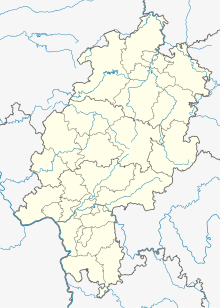Elbrighausen
Coordinates: 51 ° 4 ′ 14 " N , 8 ° 34 ′ 33" E
Elbrighausen is a deserted village in the district of Bromskirchen in the northern Hessian district of Waldeck-Frankenberg .
Geographical location
The settlement was on 411 m above mean sea level about 100 m north of the confluence of two small streams in there brought flowing from the west and then south-deflecting according Elbrighäuser Bach and a pent-up there pond . Bromskirchen is about 4.75 km east-northeast, the hamlet of Neuludwigsdorf belonging to Bromskirchen is about 1.3 km east-northeast. The border between the districts of Bromskirchen and Battenberg runs not far south of the desert and the ruins of the former forester's house built later on the northern edge of the Bachtal.
history
The settlement was first mentioned in 1338 as "Elverinchusen", when Konrad von Diedenshausen held the bailiwick of Count Gottfried IV of Arnsberg as a fief . The Cistercian convent of St. Georgenberg Monastery in Frankenberg acquired property in Elbrighausen in 1369 and 1372. When Gerlach von Diedenshausen sold first half of the village in 1394/1395, then the whole place with bailiwick and church fiefdom to Broseke (Ambrosius) von Viermünden , the place was called a village with its own parish . In 1539 Hermann I von Viermünden sold the now desolate place with bailiwick, district, court and church fiefdom to Landgrave Philip I of Hesse , who was not interested in resettlement, but in hunting in the extensive and game-rich forests of the Rothaar Mountains. The administration of the area was assigned to the Wolkersdorf Office and the Lower Court of Bromskirchen.
Forsthaus Elbrighausen
Philip's son Ludwig IV , who inherited the Landgraviate of Hesse-Marburg when the Landgraviate of Hesse was divided by his father , had a hunting lodge built on the site of the disappeared settlement in 1591. After Ludwig's death in 1604, this part of his Landgraviate fell to the Landgraviate of Hesse-Kassel and in 1624 as part of the so-called "Hinterland" to the Landgrave of Hesse-Darmstadt , and the hunting lodge became a Landgrave's forester's house around 1750 and from 1854 the seat of a chief forester's office in the Grand Duchy of Hesse . Until 1965, the house and its outbuildings served as the headquarters of a Hessian forestry office. Then the buildings were demolished, and today only remnants of the enclosing walls of the ground floor with younger built-in windows and an original, sandstone-framed door, as well as various remains of an enclosure made of quarry stone in the area. The upper floors built from half-timbered houses have completely disappeared. A sign reminds of the former forester's house. A half-timbered shed was dismantled and today, finely renovated, stands on the grounds of the Viermünden Castle .
In front of the wall is a copy of the so-called “deer stone” (the original is now in front of the city museum in Battenberg ), which recalls the times of the landgrave's hunting and the “Battenberg stag”, which was caught alive here in 1762 and then 1765 pushed 32 ends in the zoo of the Kranichstein hunting lodge near Darmstadt .
Web links
- Elbrighausen, Waldeck-Frankenberg district. Historical local dictionary for Hessen. In: Landesgeschichtliches Informationssystem Hessen (LAGIS).
- Cultural monuments in Hesse: ruins of Forsthaus Elbrighausen
- Forsthaus Elbrighausen, undated photo . Historical local dictionary for Hessen. In: Landesgeschichtliches Informationssystem Hessen (LAGIS).
literature
- Matthias Seim & Christel Kahler (arr.): Historical description of the Battenberg office around 1750. Battenberger Geschichtsblätter No. 41, Geschichtsverein Battenberg, Battenberg, 2018, p. 28
- Klaus Böhme: Hunting and hunting lodges of the Landgraves of Hesse-Darmstadt in the former Battenberg office. Battenberger Geschichtsblätter No. 39, Battenberg History Association, Battenberg, 2013
- Bromskirchen parish council (ed.): 750 years of Bromskirchen. Self-published, Bromskirchen, 1988, p. 41
- Georg Wilhelm Justin Wagner: The desertions in the Grand Duchy of Hesse. Province of Upper Hesse . G. Jonghaus Darmstadt, 1865, p. 363
Footnotes
- ↑ Later spellings of the place name were "Elbirshusin" (1369), "Elbirnshůsen" (1372), "Elberchußen" (1394), "Elberchusen" (1395), "Elbrighausen" (1539) and "Elbigshausen" (around 1750).
- ↑ August Heldmann: The family of Viermünden (Viermund, Virmont) , in: Journal of the Association for Hessian History and Regional Studies , New Series, Volume 27, Kassel, 1903, pp. 89–222 (here 126)
- ↑ In the glue pit (corridor: 24, parcel: 4).
- ^ Cultural monuments in Hesse: Viermünden Castle
- ↑ NaBu Waldeck-Frankenberg: Elbrighäuser Bach nature reserve
